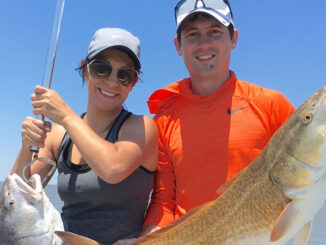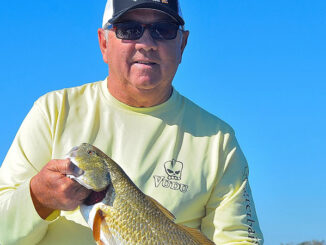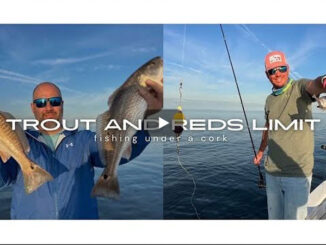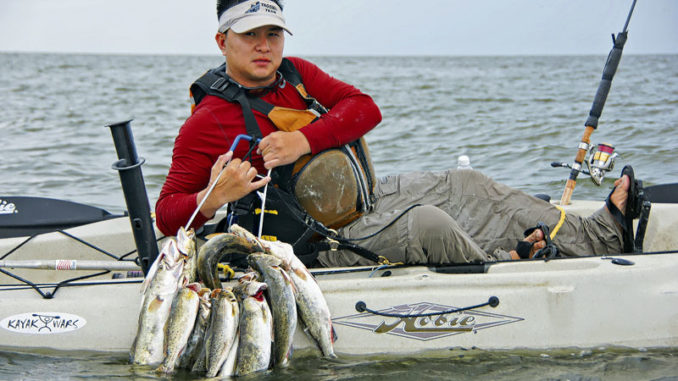
Pedal-power, trolling motors make this technique a winner in kayaks
Trolling is a traditional way of catching fish in many parts of the country; however, the technique sees limited action in much of Louisiana. At certain times, anglers in powerboats troll around the bridge pilings in Lake Pontchartrain, seeking big speckled trout. That’s about the only time you see any significant number of inshore anglers using this technique. It takes some practice but can be highly effective.
Kayak trolling while paddling can be done, but it can be strenuous and hard to coordinate. But nearly every major manufacturer offers at least one model of pedal-powered kayak. Pedaling makes trolling nearly effortless and frees your hands for holding the rod or getting to one in a rod holder without the delay of stopping and laying down your paddle.
In addition to pedal kayaks, there is an increasing trend for adding electric trolling motors to kayaks. They are designed for quiet propulsion and are great for trolling in a kayak.
Spring is an excellent time to try your hand at trolling. Fish are more spread out, and trolling allows you to cover a lot of water and have at least one bait in the water the whole time. However, it should not be undertaken haphazardly. If you’re trolling a large lagoon or lake, it’s best to cover the area in a grid pattern to avoid repeating passes over unproductive water or worse yet, missing spots where fish are holding. Additionally, by traveling in a set pattern, you can also easily make repeat passes over locations where you have success.
Fish move back and forth between deeper and shallower areas in spring as the conditions dictate. This can even occur over the course of a single day. If you’re not finding them shallow, move to a deeper canal or bayou to see if they’re holding there. Adjust your lines, lures and speed accordingly to have the baits running deeper.
A depth finder with a GPS route tracker is a great accessory for seeing your travel routes. Set a path, and you can simply follow the lines laid down with each pass.
Pay attention the whole time and make mental notes of what’s working. Speed, depth, right side, left side and how far back the lures are running are all parts of successful trolling. Having two lines out not only doubles the chance of a hookup, it allows the use of different lures and techniques to work out what works best. Keep one rod in a secure rod holder and the other in your hand. Holding the rod allows you to twitch, pull, pop or impart other action into the lure that may be the key to triggering strikes.
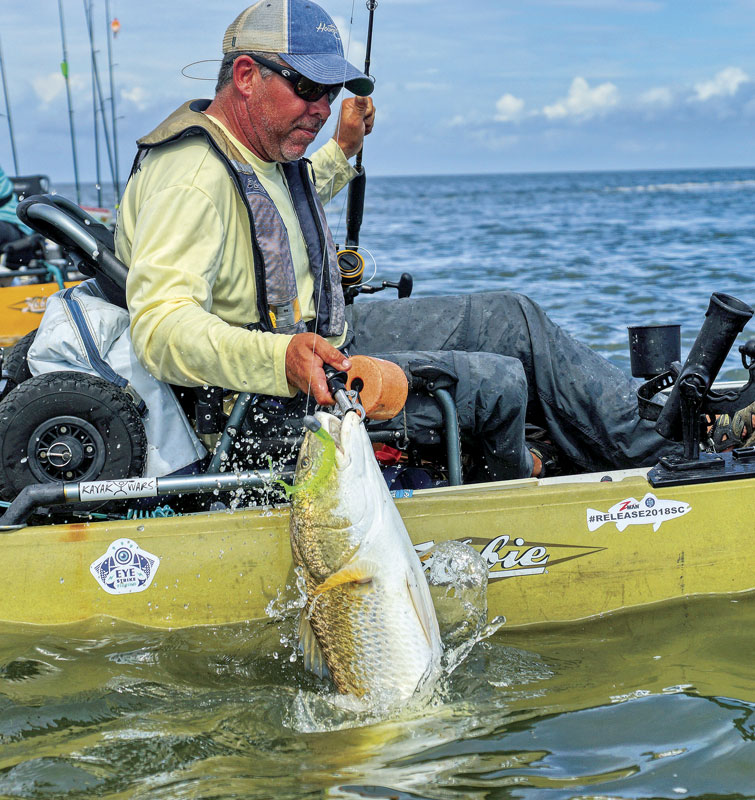
How many is too many?
If two lines are good, wouldn’t three or four be even better? Not in a kayak. You should resist the temptation to put out additional lines. Owing to the confined space, lines run too close to each other, and tangles are a near certainty — not to mention the mess that can come from a hooked fish crossing all of the lines. Consistency is key. Once you figure out what is working best, get baits on both rods performing the same way, and the success rate generally increases.
For artificial lures, a wide variety lends themselves to successful trolling. A jighead/plastic tail combination is one of the simplest and easiest to master. Try getting the lure to bounce along the bottom by adjusting by the weight of the jig and letting more or less line let out behind the kayak. If you have an area with a lot of grass, a weedless jighead keeps from constantly getting the lure fouled with grass. Never continue to fish the lure fouled with even a speck of grass; it is a waste of time. Fish almost never strike a lure with any amount of grass attached.
Shallow-diving or suspending hard baits are also highly effective. They have action and vibration while trolling, and the treble hooks basically set themselves due to the forward motion of the kayak. If the rod is in your hand, there is always the natural reaction to set the hook. When trolling, however, get in the habit of simply sweeping the rod forward rather than a snappy hookset. If the rod is in a holder, rather than grabbing for it, an easy technique is to give a quick pedal or two; the motion of the kayak will help set the hook.
Spoons, spinnerbaits and crankbaits — lipped and lipless — are all effective when trolled.
Don’t forget live bait
An often overlooked, but extremely effective method is to troll a live minnow. Cocahoe minnows are extremely hardy and stay alive well when trolled at a kayak’s slow speeds. A small No. 1 or No. 2 live-bait hook works well and allows the minnow to move naturally while being pulled. Thread the hook through the front of both eye sockets, through the nostrils or through the lips from the bottom up. Place a small lead split-shot about a foot up the line to keep the minnow from dragging on the surface.
Get in the kayak and start trolling. It is fairly easy to learn and can be highly productive.
